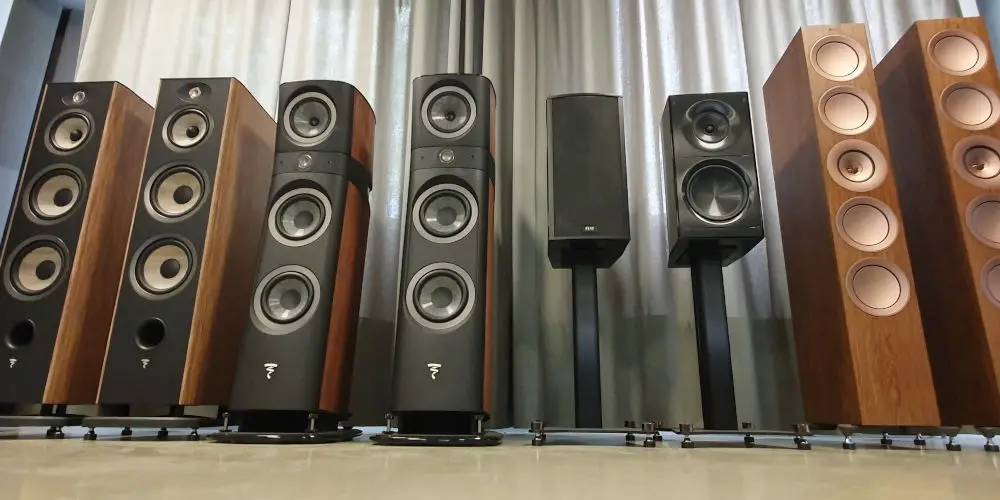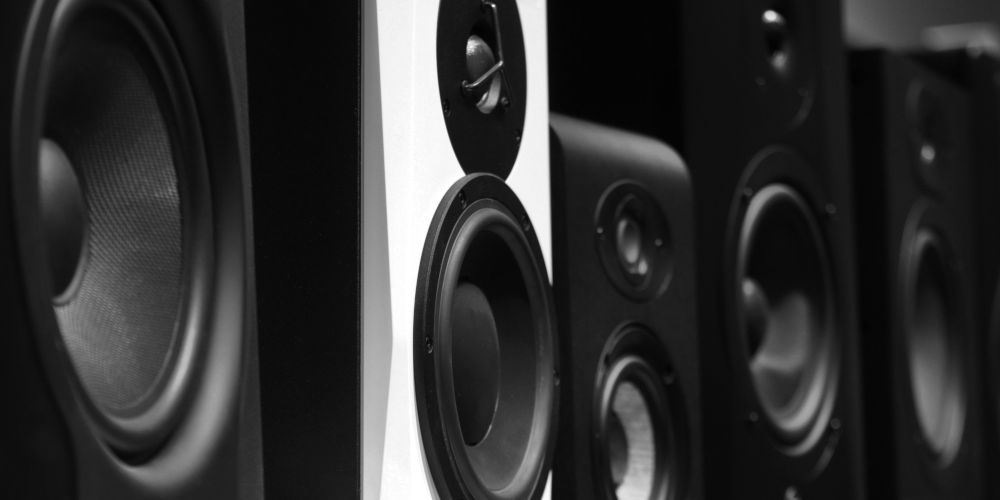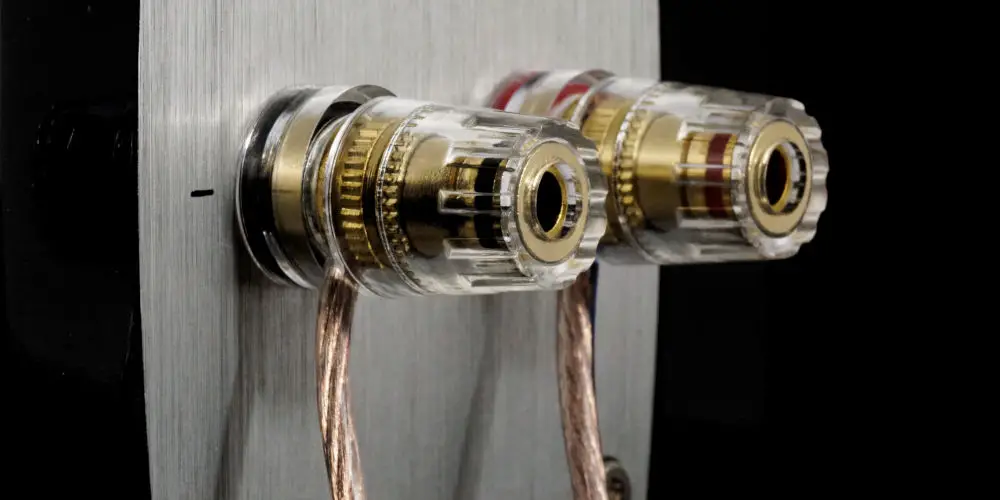What’s the difference between 4 Ohm vs 8 Ohm speakers?

If you’ve ever looked at the rear of a speaker, you’ll notice the word Ohm. You’ll typically see 4 or 8 Ohms written above the connections. But you might wonder what’s an Ohm? Is there any difference between 4 Ohm vs 8 Ohm speakers? How does the Ohm rating affect what you hear?
All are valid questions, and we’ve asked them multiple times. While they sound like boring technical terms, it’s understanding Ohm ratings and impedance is important to ensuring your H-Fi or speaker system works properly and sounds the best it can.
In this post, we will compare 4 Ohm vs 8 Ohm speakers. You’ll learn about their differences and the elements that affect their performance. We’ll also cover impedance and why it’s so important. By the end, you’ll be able to use the knowledge to select the ideal speakers for your audio system.
What is speaker impedance?
Let’s start with the basics. Speaker impedance is the electrical resistance of a speaker to the current flowing through it. We measure it in Ohms (Ω). The lower the impedance, the easier it is for current to flow through the speaker and the more power the speaker will draw from the amplifier.
Speaker impedance range covers from 1 Ohm to 100 Ohms. However, the majority of speakers in your home are 4, 6, or 8 Ohms. Most amplifiers work best with 8 Ohm speakers. Some will also work with 4 Ohm speakers. Hence, we should understand the difference between 4 Ohm vs 8 Ohm speakers.
Connecting speakers with a lower impedance than the amplifier is designed for could result in the amplifier distorting the sound. If you connect speakers with a higher impedance than the amplifier is designed for, the amplifier may struggle to deliver enough power to the speakers.
So, it is best to match the impedance of the speakers to the amplifier as closely as possible. If you are unsure what the impedance of your speakers, you’ll want to check the manufacturer’s specifications.

Why is it essential to understand speaker impedance?
There are many reasons why speaker impedance is important. Here are the most important of them.
Amplifier power
Understanding speaker impedance is critical for matching it with the amplifier’s output impedance. Ideally, the speaker’s impedance should equal the amplifier’s output impedance.
If they don’t match, you potentially could damage the amplifier or speaker as an inefficient power transfer can occur. Connecting a low-impedance speaker to an amplifier with higher-impedance output could cause the amplifier to overheat or give inadequate power to drive the speaker.
Amplifiers perform best within a specific impedance range. When the speaker’s impedance meets the amplifier’s recommended impedance, you’re operating within the sweet spot. So, you get the most power from a particular amplifier, which results in higher sound quality and volume.
Amplifier speaker compatibility
Matching the speaker’s impedance to the impedance range of the amplifier is critical. Many amplifiers indicate an allowable range of speaker impedance. Using a speaker in this range ensures that the amplifier and speaker perform efficiently together, avoiding any difficulties.
Some amplifiers include built-in safeguards that may activate if the speaker impedance is too low or too high. These safeguards protect the amplifier from potential damage caused by impedance mismatches.
Optimised for sound quality
By matching the impedance of the speakers and amplifier, you’ll get the best sound quality. Otherwise, it’ll sound weak and lifeless.
Ensuring speaker efficiency
You can maximise the power transfer efficiency by correctly matching the speakers’ and amplifier’s impedances. When they match, the combined system will transfer electrical power more efficiently into acoustic power.
The result is larger sound levels may be achieved with less electricity, making the system more energy-efficient.
What can go wrong if the impedance is mismatched?
If you connect a 4 Ohm speaker to an amplifier that isn’t designed for it could result in you overloading the amplifier and maybe damaging it. Connecting an 8 Ohm speaker to an amplifier designed for a 4 Ohm load might result in insufficient power delivery and poor performance.
Second, impedance matching has a direct effect on sound quality. The result is a more balanced frequency response and precise audio reproduction. Misalignments can cause distortion and unequal sound distribution.
Third, there is a concern about efficiency. Using a 4 Ohm speaker with a 4 Ohm amplifier improves power transfer, allowing you to achieve the highest volume and clarity without straining or wasting energy.

What’s the difference between 4 Ohm vs 8 Ohm speakers?
The fundamental distinction between the 4 ohm vs 8 ohm speaker is their electrical resistance, or as it’s commonly known, impedance. Here’s a side-by-side comparison of the 8 ohm and the 4 ohm speaker.
Electrical resistance
A 4 ohm speaker has less electrical resistance than an 8 Ohm speaker. So, the 8 Ohm speaker provides additional resistance to the electrical current running through it.
Amplifier compatibility
8 ohm speakers are more common, so they work with the vast majority of amplifiers. They are often the default option for home audio systems and home cinema speakers.
A 4 ohm speaker requires an amplifier that can handle lower-impedance loads. Using a 4 ohm speaker with an amplifier that isn’t designed for it may result in overheating or possibly amplifier damage.
Power handling
The 8 ohm speaker has a higher power handling capacity than the 4 ohm speaker. When used in conjunction with an appropriate amplifier, they can produce higher sound volumes with less distortion.
Efficiency
An 8 ohm speaker is more efficient at converting electrical power into sound, resulting in a higher output for the same input power. However, depending on the specific speaker design, its efficiency can vary.
Heat dissipation
Because of the greater current flow, a 4 Ohm speaker may emit more heat than an 8 Ohm speaker. So, if you’re using a 4 Ohm speaker, ensure there’s plenty of airflow and ventilation around the amp and speaker.
How does impedance factor in when connecting two or more speakers?
When connecting more than one 4 Ohm speaker in an audio system, you need to consider the overall impedance load to guarantee safe and optimal performance.
In a series connection, you can add the impedance of the speakers together, which is useful when dealing with several 4 Ohm speakers because it increases the total impedance. Connecting two 4 Ohm speakers in series, for example, results in an 8 Ohm total load.
In a parallel connection, the impedance is divided by the number of speakers, lowering the overall impedance. When you connect two 4 Ohm speakers in parallel, you get a 2 Ohm load, which can be problematic if your amplifier isn’t designed to handle such low impedance.
Most of us will have this problem whether we need to choose the 4 Ohm speaker or the 8 Ohm speaker. After reading this post, we hope you better understand Ohm and impedance and also answer which speaker you need to use.





